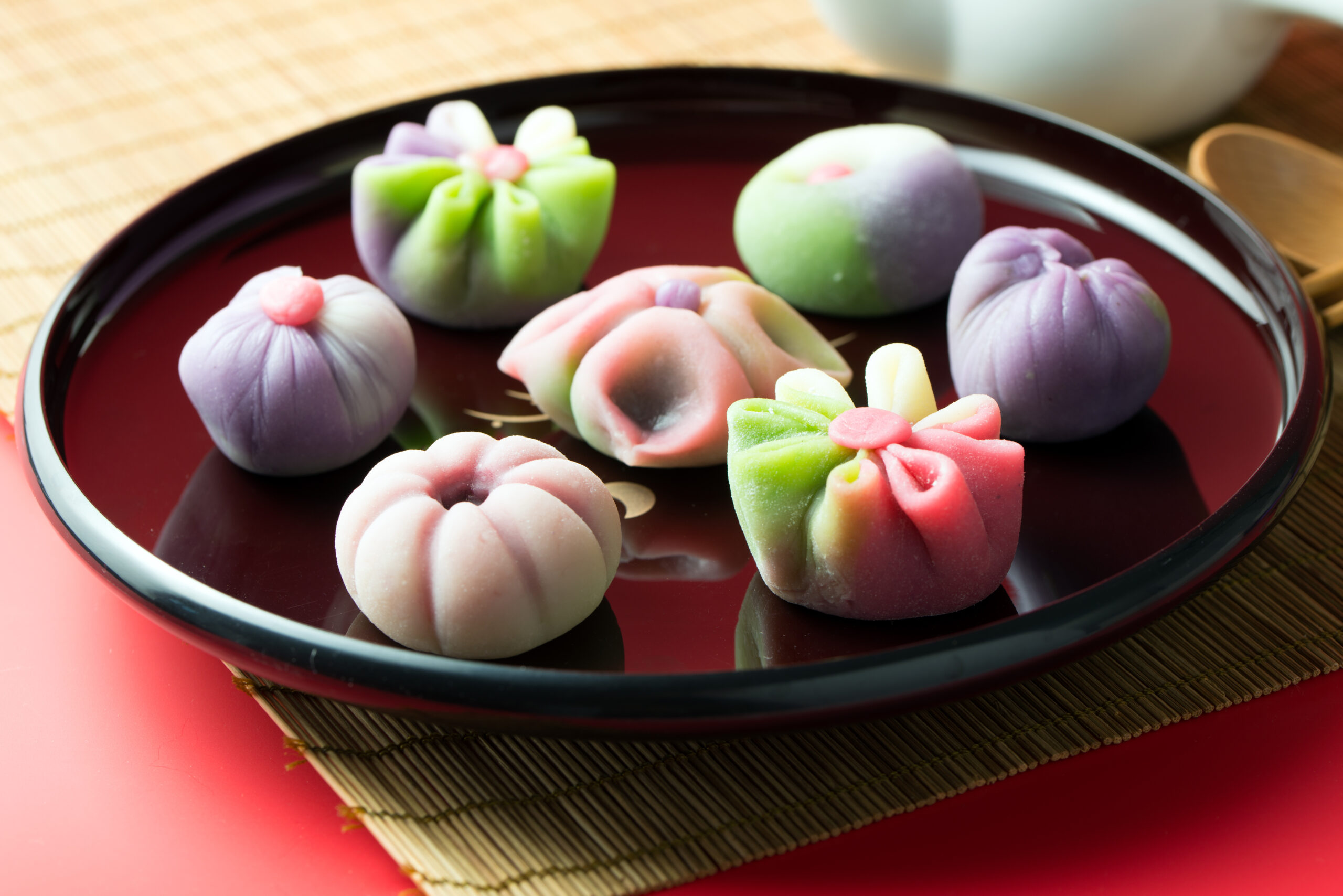Japan stretches across vast and diverse regions—from the wild nature of Hokkaido to the tropical islands of Okinawa. You’ll find rural traditions in Tohoku, spiritual heritage in Shikoku, vibrant city life in Kanto, living history in Kansai, and volcanic flavors in Kyushu. Each area has its own identity and unique charm. At Encounter Japan Travel, we design tailor-made experiences that connect travelers to this rich cultural and geographical variety. To fully enjoy it, understanding how to get around Japan is essential.
Exploring Japan goes beyond visiting temples or tasting sushi—it means discovering a wide range of landscapes and ways of life. Whether you’re taking a bullet train (shinkansen), a local bus, a taxi, or private transport, moving between regions is a key part of the journey.
Here’s everything you need to know to plan your transportation in Japan efficiently.
The Shinkansen: Speed and Comfort
Japan’s world-famous shinkansen (bullet train) connects major cities at speeds of up to 320 km/h. Its extensive network links the country efficiently, with the Tokaido Line—Japan’s busiest route—connecting Tokyo and Osaka with frequent departures, especially during peak hours.
- Heading north, the Tohoku Line links Tokyo to Aomori, opening the gateway to Japan’s northern regions.
- In the south, the Kyushu Line reaches Kagoshima with ease.
- Construction is also underway to extend the Hokkaido Line to Sapporo, further improving the network.
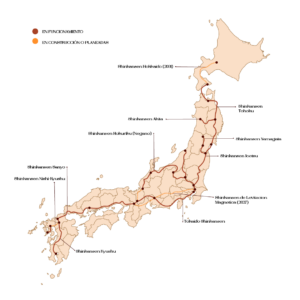
The shinkansen offers various seat classes for different travel styles.
- Non-reserved seats are flexible and ideal during low season.
- Reserved seats ensure you always have a spot, especially in peak travel periods.
- For greater comfort, Green Car offers spacious seating and added services.
- For a luxurious onboard experience, Gran Class features reclining seats, personalized service, and gourmet meals—making the journey part of the destination.
*Travel tip: If you’re traveling with oversized luggage (total dimensions between 161–250 cm), you’ll need to reserve a storage space in advance. The service is free but must be booked ahead of time.
Ta-Q-Bin: Travel Light
One of the greatest conveniences in Japan is the Ta-Q-bin luggage delivery service. It allows travelers to ship their suitcases directly to their next hotel, letting them move freely and comfortably.
Delivery usually takes 1–2 days and is easily arranged at hotels, airports, or convenience stores. Available year-round, it’s a simple way to make every trip lighter and stress-free.
JR Trains and Regional Rail: Full Coverage Across Japan
- The JR (Japan Railways) network spans nearly the entire country, connecting major cities with rural areas. In urban centers, trains run every few minutes, while in remote areas, services may be spaced an hour or more apart.
- Most trains operate between 5:00 AM and midnight, with some continuing until 1:00 AM in larger cities—providing nearly full-day transportation coverage.
IC Cards: Simple, Efficient Travel
IC cards like Suica, Pasmo, or ICOCA make it easy to get around in Japanese cities. These rechargeable smart cards work on trains, subways, buses, and even in convenience stores and vending machines.
They can be topped up at station kiosks or via mobile apps. For tourists, the Welcome Suica is ideal: no deposit required, valid for 28 days, and designed to make travel smoother and faster.
Japan Rail Pass: Unlimited Travel Made Easy
For travelers exploring multiple regions, the Japan Rail Pass is a cost-effective option offering unlimited JR train travel for 7, 14, or 21 days. Regional passes—like the Kansai or Kyushu versions—are even more affordable and include both local and long-distance trains.
*Important: The JR Pass cannot be used on Nozomi or Mizuho trains and must be purchased before arriving in Japan—making it ideal for planning your itinerary in advance.
Taxis in Japan: Private, Punctual, Premium
Taxis in Japan are clean, punctual, and safe—perfect for night transfers, heavy luggage, or elderly travelers. Though more expensive than trains or buses, taxis offer unmatched comfort and convenience.
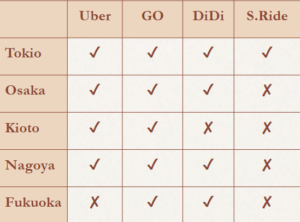
You’ll find taxis outside most train stations, hotels, and shopping centers. They can also be booked via apps like Uber, GO, DiDi, or S.Ride, depending on the city.
Tip: A red light in the windshield means the taxi is available. Green or no light means it’s occupied.
Fares are calculated by meter. While most accept cash, many now also accept credit cards or mobile payments—though it’s best to carry yen just in case.
City Buses: A Local Alternative
City buses are practical for exploring areas not easily reached by train. Each region operates slightly differently:
- In Tokyo, pay when you board.
- In Kyoto, pay when you get off.
- In Osaka, buses complement the subway system and serve many tourist areas.
You can pay with IC cards like Suica/Pasmo, in cash, or via mobile apps like Mobile Suica. Be sure to have small change or a fully charged IC card.
Useful passes include:
- Toei Pass in Tokyo (bus, subway, streetcar)
- Amazing Osaka Pass (transport + attraction entry)
- Kyoto Bus + Metro Pass (ideal for visiting temples and historic sites)
Regional Airports: Go Beyond Tokyo and Osaka
In addition to Tokyo’s Haneda and Narita airports and Osaka’s Kansai Airport, Japan has a well-connected network of regional airports. Domestic flights are ideal for reaching remote areas or saving time when traveling to places like Okinawa, Yakushima, or northern Hokkaido.
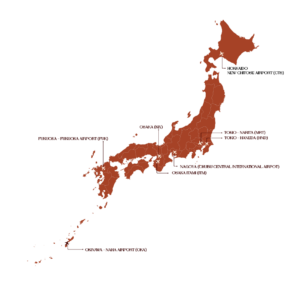
Sample Flight Times Between Major Airports (hours : minutes)
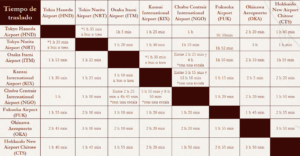
Private Transportation with Encounter Japan Travel
For travelers seeking a seamless and exclusive experience, Encounter Japan Travel offers premium transportation options: chauffeur-driven vehicles, private catamarans, and helicopter transfers—designed for maximum comfort, efficiency, and flexibility.
- Private cars offer full privacy and luxury, ideal for long transfers or city touring.
- Private catamarans are perfect for connecting islands while enjoying serene marine views.
- Helicopters dramatically reduce travel time and provide breathtaking aerial views of Japan’s landscape.
Download the Full Guide
Want the full presentation in PDF format? Email us at
We’ll be happy to send it to you.
Watch the Webinar on YouTube
Discover more expert tips and learn how to plan premium trips across Japan by watching our full webinar on YouTube.
🎥 Watch the video here
Subscribe for Exclusive Travel Insights
Sign up for our newsletter and receive insider content straight to your inbox: travel planning tips, updates on the Japanese market, and new collaboration opportunities tailored for travel professionals like you. Stay connected with the best of Japan.

